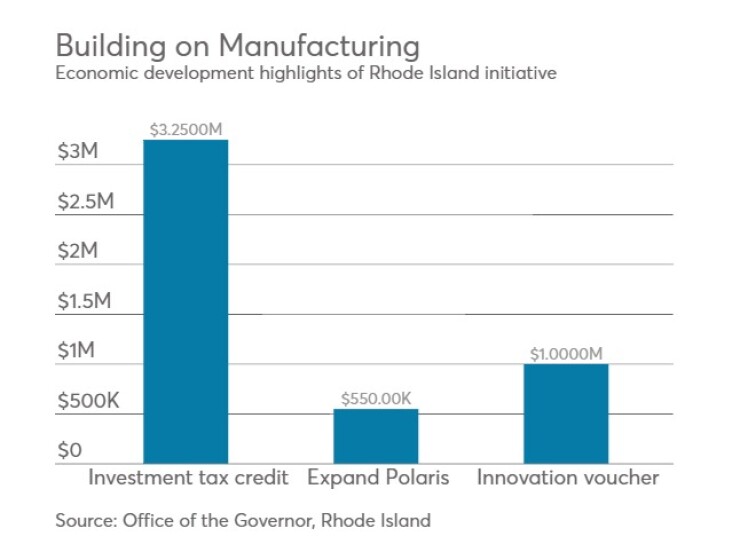

Rhode Island wants to modernize its manufacturing industries with an initiative focused on economic development and expansion.
It's all with an eye toward boosting the state's economy.
"We have a new set of inventive tools and instruments," Stefan Pryor, Rhode Island's first commerce secretary, said in an interview.
Gov. Gina Raimondo on Jan. 26 unveiled the Rhode Island Manufacturing Initiative package, which included an executive order establishing an advisory council.
"For too many years, our state's leaders in government and business missed an opportunity to rebuild Rhode Island's manufacturing industry," she said.
Rhode Island is trying to play catch-up economically.
Moody's Analytics, in its overview of the state, rated Rhode Island 47th among the states in risk exposure, 42nd in employment growth and 49th in vitality. It cited fewer new jobs in medium-paying industries, a high tax burden, poor infrastructure, and domestic outmigration – with its spillover effect on the housing and consumer industries -- as the state's biggest weaknesses.
"Rhode Island's population has been relatively flat since the turn of the century, lagging well behind national growth," according to a Fitch Ratings analysis. "The state is also slightly older than the national median."
Raimondo, since taking office in January 2015, has hinged her administration on economic improvement. One of her first moves was to create the position of commerce czar.
"Gov. Raimondo is ever at it," said Pryor. "She's very hands on. She networks effectively and makes sure we have access to these executives. She strategizes in an incredibly smart way."
The initiative combines economic development and workforce training.
Economic development thrusts include $3.25 million to establish a manufacturing investment tax credit that provides manufacturing businesses with a refundable tax credit on a competitive basis to purchase new equipment; $550,000 to expand technical assistance under the Polaris MEP (Manufacturing Extension Partnership) for local manufacturing companies; and $1 million -- of $2.5 million -- in an innovation voucher program dedicated to supporting manufacturers' in-house research and development.
The measure also calls for new language in the qualified jobs incentive tax credit program that reduces the minimum hiring requirement for expanding manufacturers, and establishes an Innovation Center for Design and Manufacturing to help entrepreneurs scale up and bring ideas to prototype and eventually to market.
All the components are parallel, according to the Yale-educated Pryor.
"The manufacturing plants of old were dark, dirty and unappealing. These modern manufacturing plants that have survived and thrived have workers that are well-trained," he said. "They are advanced industrial plants, with computerized technology and advanced business systems. They offer in many cases family-sustainable wages and very decent working conditions."
Pryor's career has also intersected with economic development and education. Before Raimondo hired Pryor, he was Connecticut's education commissioner for four years. He was president of the Lower Manhattan Development Corp., created after 9/11, for the first five years of New York's rebuilding from the terrorist attacks, then spent the following five years as deputy mayor in Newark, N.J., under Cory Booker, his college friend and now New Jersey's junior U.S. senator.
"These two areas interweave," he said. "It's important to create jobs that are fairly sustainable and equally important to build a first-rate educational system. I've had the privilege to work in both fields."
To that extent, said Pryor, the manufacturing thrust intersects with Raimondo's "Rhode Island's Promise" free college proposal, which she announced one week earlier at her State of the State address. It would guarantee every Rhode Island student an opportunity earn an associate's degree from Community College of Rhode Island or attend the University of Rhode Island or Rhode Island College tuition free their junior and senior year.
Raimondo's initial $10 million phase-in of free tuition is part of her $9.3 billion budget proposal for fiscal 2018, which state lawmakers are considering.
The workforce component includes $3.65 million to enhance manufacturing programs at the Davies Career and Technical High School in Lincoln; $2 million for the job-ready workplace learning program to provide refundable job training tax credits on a competitive basis to help support job training; and $1.2 million to invest in the state's Pathways in Technology Early College High School, or P-Tech, initiative to continue the manufacturing training partnership at Westerly High School and potentially create another partnership related to manufacturing.
Raimondo made her announcement during a visit to Luca + Danni, a Cranston-based jewelry manufacturer. Cranston is also home to the Rhode Island Jewelry Museum. The state is rich in manufacturing history, notably watchmaking.
"Rhode Island has a strong manufacturing heritage in general and a rather glorious one of jewelry in particular," said Pryor. "We wanted to highlight a smaller, energetic jeweler with a strong heritage and a promise for the future."
Moody's Investors Service rates Rhode Island's general obligation bonds Aa2. Fitch Ratings and S&P Global Ratings assign AA ratings. All three assign stable outlooks.
According to Fitch, Rhode Island's "relatively high" concentration of colleges and universities, and slightly above-average educational attainment levels, reveal growth potential.
"Rhode Island's economy, weighted towards education and health services, has grown slower than national trends with a demographic profile weaker than most states," said Fitch. "The state's economic decline was among the worst of the states during the great recession in terms of job losses, and the pace of recovery has lagged the nation."
The report also cited the abrupt halt to spillover growth from Boston, 50 miles north.
"Software and biotech investment in Boston has declined amid a further reduction in venture capital, and this has put commuter jobs in Rhode Island at risk," said the report. "Siphoning economic activity away from Boston may be R.I.'s most promising avenue for longer-term growth, but stemming the outflow of educated youth is a bigger priority in the short term."
Brookings Institution,
"Tech-intensive New York, Massachusetts, Rhode Island, Maine, New Hampshire, and Connecticut all saw significant quickening of their output and employment growth," said Brookings.
Alan Schankel, a managing director at Janney Capital Markets in Philadelphia, sees the new twist to manufacturing in certain regions.
"Certainly you see that with the tech hub up in Boston and it's developing to some extent down here in Philly," he said. "It's still manufacturing, just different stuff. I'm sure the cost of land and facilities in Rhode Island is cheaper than it is in Boston."
Advanced industries, according to Brookings, spend at least $450 per worker per year on research and development and employ at least 20% of their workforce in Stem-intensive occupations. Stem is an acronym for science, technology, engineering, and math.
"Advanced industries encompass the nation's 'tech' sector at its broadest and most consequential. They represent a sizable economic anchor for the U.S. economy and have led the post-recession employment recovery," said Brookings.





